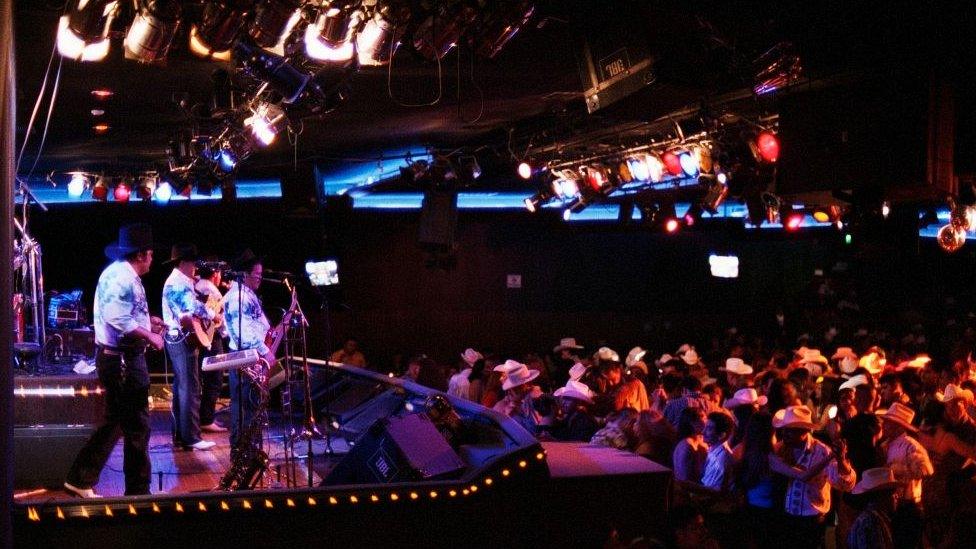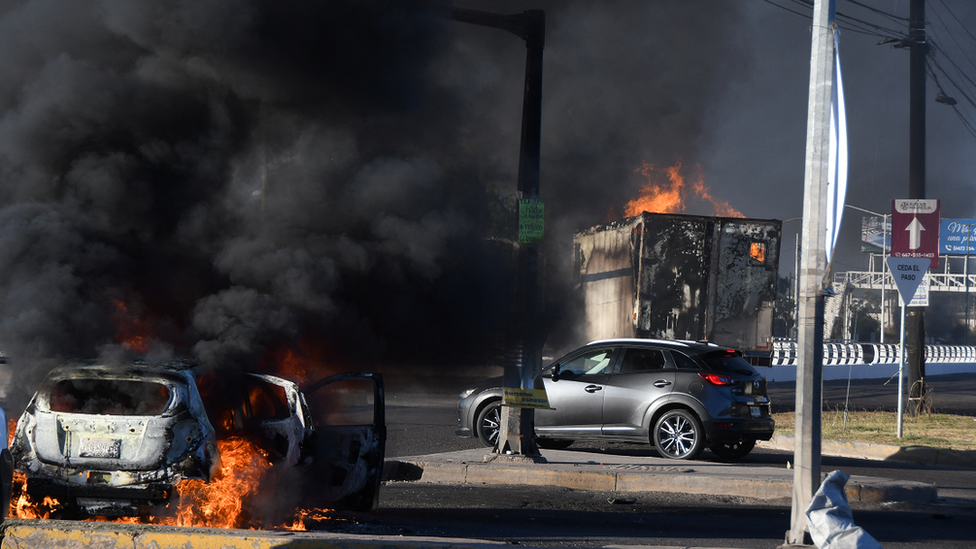Narcocorridos: Mexico's bloody drug ballads have American ears tingling
- Published

Narcocorrido concerts have been held in states such as California and Texas for years, but some say its popularity is waning
Set to the tune of accordions and trumpets, the ballad "In Preparation" by California native Gerardo Ortiz could be mistaken for a jaunty polka.
But its lyrics are chilling and brutal.
"If you aren't good at killing," Mr Ortiz blares, "then you're good at dying."
The song goes on to describe a combat-ready gunman with a penchant for trucks and his AK-47 who goes by a "respected" codename: M1.
The man depicted is not fiction. M1 was the codename of a notorious Sinaloa Cartel drug trafficker, Manuel Torres Felix - or "the Crazy One" - who was gunned down in a firefight with Mexican soldiers in 2012.
M1 may be dead but his infamy - and that of other gangsters past and present - live on in "narcocorridos", or drug ballads, which can be heard everywhere from small town fairs to nightclubs throughout Mexico.
The music draws on a deep tradition dating as far back as the Mexican Revolution, but with the zeitgeist of language and action ripped straight from the headlines.
Little wonder, then, that amid the grim reality of today's long and losing battle against cartel violence, the musical genre is dividing the opinions of listeners in its country of origin, as well as new audiences north of the border.
While the style of Mexican narcocorridos dates back to at least the early 20th Century, the genre - which has often been compared to the American tradition of gangster rap - first became popular in the US in the 1980s.
Its initial popularity in the US was largely due to Chalino Sanchez, a Mexican immigrant in the Los Angeles area still popularly known as the king of narcocorridos.
Sanchez's life, in many ways, was as violent as the subjects of his music. In 1992, he narrowly escaped death after being shot twice in a gunfight at a California concert.
Four months later, he was kidnapped and executed just hours after receiving a threatening note while on stage at a concert in Mexico.
Listen to the 'drug ballads' popular in California
In the decades after his death, the genre he popularised has remained a draw for many Mexicans and Mexican-Americans in the US, where it has a dedicated audience.
"I like that the music tells real stories of real people," said Alex Fernandez, a first-generation American who lives in southern California, just a few miles from the border with Mexico. "People like crime movies, or gangster rap. It's the same thing."
Firm numbers of US-based listeners of narcocorridos are hard to come by, but the potential audience is in the millions. Mexican "regional music" - the broad genre in which corridos fall - is the strongest performing format among Hispanic radio consumers, according to Nielsen.
The audience among streaming listeners is potentially even larger, with Spotify noting that the volume of streams of the genre has more than doubled since 2019 to reach 5.6bn - 21% of which is from the US.
Among the songs currently on his corrido playlist, Mr Fernandez tells the BBC, is "30 Armoured Trucks", a song about a convoy of vehicles working at the behest of Mexico's Sinaloa Cartel.
Another song - El "Raton", or "the mouse" - is sung from the perspective of Ovidio Guzman Lopez, the son of imprisoned cartel boss Joaquin "El Chapo" Guzman, whose arrest this month led to a series of fierce gun battles and dozens of deaths.
"I don't know fear," the singer croons. "A Guzman can't be intimidated, especially by the government."
The content of the music - much of which is inspired by real people and events - has prompted recent bans on radio circulation and live performances in some parts of Mexico and at events seen as potentially related to the drug trade.
In November, organisers of a weeks-long livestock festival in the violence-plagued Mexican state of Sinaloa announced that corridos were forbidden because they promote bloodshed.
But for many US listeners, the content of the music - which often portrays drug traffickers as Robin Hood-like figures opposing the government - is part of the appeal.

Many narcocorridos have focused on the Sinaloa Cartel and imprisoned boss Joaquin "El Chapo" Guzman
The popularity of the music among some US-based listeners is directly comparable to the rise of gangster rap in the mid-1980s, according to Rafael Acosta, a professor at the University of Kansas who has studied narcocorridos.
"Gangster rap has been naturalised into massive culture, and it's not very different, in function, even if it is in style," he said.
Narcocorridos tell the stories of "people who feel, many times justifiably, that they are neglected by state and economic apparatuses and look for possibilities of rebellion and socio-economic advancement," said Prof Acosta. He compared them to films and songs about Italian gangsters at the turn of the 20th Century or outlaws trafficking moonshine during the prohibition of the 1920s.
A backlash?
But critics who denounce the genre point to the music's relationship with real-life violent incidents and the perceived association between the musicians and criminals.
Well over a dozen narcocorrido singers have been killed in Mexico in recent years, while others have been accused by authorities of being involved in crimes themselves.
The violent nature of the music is a "complicated" issue, even for fans, said Prof Acosta.
For some, there are even signs that fatigue over years of drug-related violence in Mexico has led some fans to turn away from the music.
Howard Campbell, a professor at the University of Texas - El Paso who researches drug trafficking and the culture of the US-Mexico border, has found that the music's popularity in the region has waned.
This trend is partly due to the fact that many in El Paso have grown weary of the imagery of a drug war that has claimed thousands of lives just across the border, he said.
"How many times can you show the same narco videos, of people popping champagne with women and guns? It gets stale at a certain point," he said. "It starts to lose its chic and cool aspects. The reality is that it's a horrible situation."
"It's something that will never completely go away," he continued. "But I don't think it's likely to regain the heights that it once had."
Related topics
- Published25 May 2017

- Published6 January 2023

- Published3 January 2023

- Published14 August 2022
